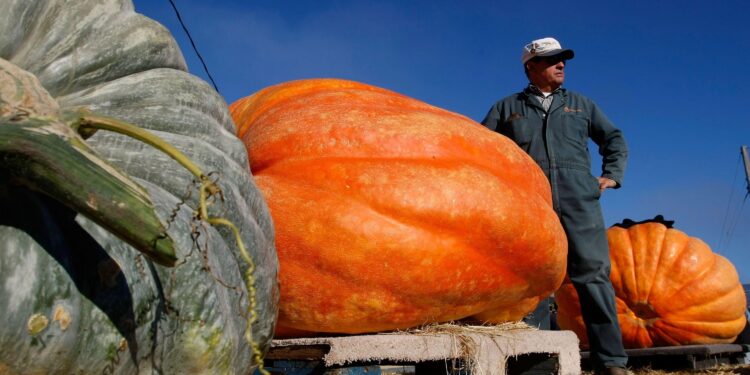Wyoming gardeners and agricultural enthusiasts are turning to science to break records in the world of giant pumpkin growing. As the annual giant pumpkin contests gain popularity across the state, researchers and experienced growers are combining traditional horticultural techniques with cutting-edge scientific methods to cultivate pumpkins of unprecedented size. This article explores the innovative strategies and scientific principles that are helping Wyoming growers push the boundaries of what’s possible, offering insights into soil composition, genetics, and growth optimization that could transform a humble garden gourd into the next colossal crop.
Selecting the Perfect Pumpkin Variety for Maximum Growth
Choosing the right pumpkin variety is a crucial first step for gardeners aiming to cultivate record-breaking giants. Varieties such as Dill’s Atlantic Giant have been scientifically proven to produce massive fruits due to their genetic potential for size and growth rate. When selecting seeds, prioritize those from suppliers known for consistent, high-quality germination and documented success in pumpkin-growing communities. Heirloom and hybrid varieties each have unique advantages: heirlooms often provide robust flavor and resilience, while hybrids engineered through selective breeding can deliver accelerated growth and higher yields.
The following table breaks down popular giant pumpkin varieties along with their average maximum weights and growth characteristics, providing a handy guide for growers who want to align their seed choice with their environmental conditions and growth goals.
| Variety | Avg. Max Weight (lbs) | Growth Rate | Ideal Climate |
|---|---|---|---|
| Dill’s Atlantic Giant | 1,200+ | Fast | Temperate |
| Big Max | 200-600 | Moderate | Warm |
| Prizewinner | 800+ | Fast | Cool |
| Gypsy | 150-300 | Moderate | Temperate |
For optimal results, growers should focus on varieties with proven performance in their region and consider factors like day length, soil fertility, and susceptibility to pests. Incorporating scientific data on genetic growth traits helps maximize the pumpkin’s biomass potential, ultimately increasing the chances of hitting those astonishing weight milestones gardeners dream about.
Optimizing Soil Conditions with Scientific Precision
Achieving record-breaking pumpkin sizes begins beneath the surface, where the right soil conditions create an environment ripe for growth. By combining traditional gardening wisdom with modern soil science, growers can optimize pH levels, nutrient availability, and moisture retention with scientific precision. Regular soil testing enables fine-tuning of amendments such as lime or sulfur to maintain an ideal pH near 6.5 to 6.8, ensuring essential nutrients are fully accessible to pumpkin roots. Additionally, integrating organic matter like compost improves soil structure, encouraging healthy root expansion and greater nutrient uptake.
The adoption of data-driven approaches, like using moisture sensors and GPS mapping, allows growers to monitor soil conditions in real time and apply targeted irrigation and fertilization. This precision not only conserves resources but also promotes vigorous vine growth and impressive fruit development. Below is a simple breakdown of key soil parameters and optimal ranges for giant pumpkin cultivation:
| Soil Parameter | Optimal Range | Impact on Growth |
|---|---|---|
| pH Level | 6.5 – 6.8 | Maximizes nutrient uptake |
| Soil Moisture | 60% – 80% field capacity | Prevents stress, encourages root health |
| Organic Matter | 4% – 6% | Enhances structure and nutrient supply |
| Phosphorus | 40 – 60 mg/kg | Supports strong root and flower formation |
Harnessing Advanced Fertilization Techniques to Boost Pumpkin Size
Unlocking the true potential of pumpkin growth hinges on precise nutrient management tailored to every growth stage. Recent advancements in fertilization technology allow growers to optimize nutrient delivery, ensuring pumpkins receive a balanced supply of nitrogen, phosphorus, and potassium, critical elements that fuel cellular expansion and fruit enlargement. Techniques such as controlled-release fertilizers and drip irrigation systems enhance nutrient uptake efficiency, minimizing waste and environmental runoff. Additionally, soil testing combined with real-time monitoring empowers farmers to adjust feeding schedules dynamically, creating ideal conditions for producing those coveted giant pumpkins.
Integrating organic amendments with advanced synthetic options also plays a pivotal role in pumpkin development. Organic matter improves soil structure and microbial activity, which in turn promotes root health and nutrient absorption. Growers are increasingly adopting precision fertilization strategies, including:
- Foliar feeding during flowering to support pollination success
- Supplemental calcium and magnesium to prevent blossom end rot and enhance fruit firmness
- Micronutrient injections to correct specific soil deficiencies identified through lab analysis
| Growth Stage | Recommended Fertilizer | Application Method |
|---|---|---|
| Seedling | 10-10-10 balanced mix | Soil incorporation |
| Flowering | High phosphorus supplement | Foliar spray |
| Fruit set | Potassium-rich fertilizer | Drip irrigation |
| Ripening | Calcium-magnesium boost | Soil drench |
Future Outlook
Growing a giant pumpkin is no longer just a matter of luck or tradition. As demonstrated by Wyoming’s local growers and agricultural scientists, applying scientific methods-from soil analysis to precise nutrient management-can significantly enhance the odds of cultivating record-breaking pumpkins. With continued research and community collaboration, Wyoming’s giant pumpkin growers are not only pushing the boundaries of size but also inspiring innovation in agricultural practices statewide. For those eager to try their hand at this seasonal feat, combining age-old passion with modern science may be the winning formula. Stay tuned to WyomingNews.com for more updates on agricultural breakthroughs and local success stories.































